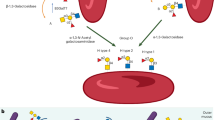Abstract
DEOXYRIBONUCLEIC acids (DNA) have been found to react with antisera prepared by immunizing animals to Gram-negative bacteria1, DNA2, nucleosides3–5, nucleotides4, purines5–7 and pyrimidines5,8. This was first demonstrated by complement fixation1,6 and then by precipitin reaction3–5. The ease and degree to which these reactions occur seem to depend on the source of the DNA. Pneumo-coccal and E. coli DNA, undenatured and denatured, fix complement with pyrimidine specific antibody; but these and calf thymus DNA are reported to require heat denaturation for complement fixation with anti-purinoyl antibody, although some complement fixation was observed with undenatured pneumococcal and E. coli DNA6,8. For precipitation, calf thymus DNA required heat denaturation to bring down anti-calf thymus2 or anti-uridine antibody3 and heat denaturation in the presence of formaldehyde to precipitate with anti-purinoyl, anti-pyrimidine or anti-nucleoside antibody5. In contrast, heat-denatured chick embryo DNA precipitated both with anti-purinoyl and anti-nucleoside antibody5. The difference in reactivity between calf thymus and chick embryo DNA was accounted for on the basis of the lack of hyperchromicity for heat-denatured chick embryo DNA and formaldehyde denatured calf thymus DNA, cycled slowly through the thermal transition temperature, compared to a hyperchromicity of 19.5 per cent for heat-denatured calf thymus DNA treated similarly5.
This is a preview of subscription content, access via your institution
Access options
Subscribe to this journal
Receive 51 print issues and online access
$199.00 per year
only $3.90 per issue
Buy this article
- Purchase on Springer Link
- Instant access to full article PDF
Prices may be subject to local taxes which are calculated during checkout
Similar content being viewed by others
References
Christian, C. L., DeSimone, A. R., and Abruzzo, J. L., J. Exp. Med., 121, 309 (1965).
Plescia, O. J., Braun, W., and Palczuk, N. C., Proc. U.S. Nat. Acad. Sci., 52, 279 (1964).
Sela, M., Ungar-Waron, H., and Shechter, Y., Proc. U.S. Nat. Acad. Sci., 52, 285 (1964).
Erlanger, B. F., and Beiser, S. M., Proc. U.S. Nat. Acad. Sci., 52, 68 (1964).
Beiser, S. M., Tanenbaum, S. W., and Erlanger, B. F., Nature, 203, 1381 (1964).
Butler, jun., V. P., Beiser, S. M., Erlanger, B. F., Tanenbaum, S. W., Cohen, S., and Bendich, A., Proc. U.S. Nat. Acad. Sci., 48, 1597 (1962).
Butler, V. P., Tanenbaum, S. W., and Beiser, S. M., J. Exp. Med., 121, 19 (1965).
Tanenbaum, S. W., and Beiser, S. M., Proc. U.S. Nat. Acad. Sci., 49, 662 (1963).
Weetall, H. H., and Weliky, N., Science, 148, 1235 (1965).
Kabat, E. A., and Mayer, M. M., Experimental Immunochemistry, second ed. (Charles C. Thomas, Springfield, 1961).
Lowry, O. H., Rosebrough, N. J., Farr, L., and Randall, R. J., J. Biol. Chem., 193, 265 (1951).
Chargaff, E., and Davidson, J. N., The Nucleic Acids, 1 (Academic Press, New York, 1955).
Author information
Authors and Affiliations
Rights and permissions
About this article
Cite this article
WEETALL, H., WELIKY, N. Precipitation of Salmon Sperm Deoxyribonucleic Acid with Purine-specific Antibody. Nature 207, 858–860 (1965). https://doi.org/10.1038/207858a0
Issue Date:
DOI: https://doi.org/10.1038/207858a0
Comments
By submitting a comment you agree to abide by our Terms and Community Guidelines. If you find something abusive or that does not comply with our terms or guidelines please flag it as inappropriate.


